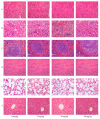The Safety Evaluation of Salvianolic Acid B and Ginsenoside Rg1 Combination on Mice
- PMID: 26690140
- PMCID: PMC4691119
- DOI: 10.3390/ijms161226176
The Safety Evaluation of Salvianolic Acid B and Ginsenoside Rg1 Combination on Mice
Abstract
Our previous study indicated that the combination of salvianolic acid B (SalB) and ginsenoside Rg1 (Rg1), the main components of Salvia miltiorrhizae and Panax notoginseng, improves myocardium structure and ventricular function in rats with ischemia/reperfusion injury. The present study aimed to determine the safety of the combined SalB and Rg1 (SalB-Rg1) in mice. The safety of SalB-Rg1 was evaluated through acute toxicity and repeated-dose toxicity. In the acute toxicity study, the up and down procedure was carried out firstly, and then, the Bliss method was applied. In the toxicity study for seven-day repeated treatment of SalB-Rg1, forty Kunming mice were randomly divided into four groups. The intravenous median lethal dose (LD50) of the SalB-Rg1 combination was 1747 mg/kg using the Bliss method. For both the acute toxicity study and the seven-day repeated toxicity study, SalB-Rg1 did not induce significant abnormality on brain, heart, kidney, liver and lung structure at any dose based on H&E stain. There were no significant changes related to the SalB-Rg1 toxicity detected on biochemical parameters for two kinds of toxicity studies. The LD50 in mice was 1747 mg/kg, which was more than one hundred times higher than the effective dose. Both studies of acute toxicity and seven-day repeated dose toxicity indicated the safety of the SalB-Rg1 combination.
Keywords: acute toxicity; ginsenoside Rg1; repeated toxicity; safety; salvianolic acid B.
Figures





Similar articles
-
Ginsenoside Rg1 and Rb1, in combination with salvianolic acid B, play different roles in myocardial infarction in rats.J Chin Med Assoc. 2015 Feb;78(2):114-20. doi: 10.1016/j.jcma.2014.10.001. Epub 2014 Dec 1. J Chin Med Assoc. 2015. PMID: 25476150
-
Combined Salvianolic Acid B and Ginsenoside Rg1 Exerts Cardioprotection against Ischemia/Reperfusion Injury in Rats.PLoS One. 2015 Aug 17;10(8):e0135435. doi: 10.1371/journal.pone.0135435. eCollection 2015. PLoS One. 2015. PMID: 26280455 Free PMC article.
-
Synergism of salvianolic acid B and ginsenoside Rg1 magnifies the therapeutic potency against ischemic stroke.Neuroreport. 2024 Nov 6;35(16):1041-1051. doi: 10.1097/WNR.0000000000002099. Epub 2024 Sep 19. Neuroreport. 2024. PMID: 39292959 Free PMC article.
-
Effects of the Combination of the Main Active Components of Astragalus and Panax notoginseng on Inflammation and Apoptosis of Nerve Cell after Cerebral Ischemia-Reperfusion.Am J Chin Med. 2015;43(7):1419-38. doi: 10.1142/S0192415X15500809. Epub 2015 Oct 18. Am J Chin Med. 2015. PMID: 26477799
-
Salvianolic acid B in fibrosis treatment: a comprehensive review.Front Pharmacol. 2024 Jul 30;15:1442181. doi: 10.3389/fphar.2024.1442181. eCollection 2024. Front Pharmacol. 2024. PMID: 39139645 Free PMC article. Review.
Cited by
-
Improved up-and-down procedure for acute toxicity measurement with reliable LD50 verified by typical toxic alkaloids and modified Karber method.BMC Pharmacol Toxicol. 2022 Jan 4;23(1):3. doi: 10.1186/s40360-021-00541-7. BMC Pharmacol Toxicol. 2022. PMID: 34983670 Free PMC article.
-
Identifying Crude Drugs in Kampo Medicines Associated with Drug-Induced Liver Injury Using the Japanese Adverse Drug Event Report Database: A Comprehensive Survey.Pharmaceuticals (Basel). 2023 May 1;16(5):678. doi: 10.3390/ph16050678. Pharmaceuticals (Basel). 2023. PMID: 37242461 Free PMC article.
-
Salvianolic Acid B Ameliorates Cerebral Ischemia/Reperfusion Injury Through Inhibiting TLR4/MyD88 Signaling Pathway.Inflammation. 2016 Aug;39(4):1503-13. doi: 10.1007/s10753-016-0384-5. Inflammation. 2016. PMID: 27255374
-
Natural products: potential treatments for cisplatin-induced nephrotoxicity.Acta Pharmacol Sin. 2021 Dec;42(12):1951-1969. doi: 10.1038/s41401-021-00620-9. Epub 2021 Mar 9. Acta Pharmacol Sin. 2021. PMID: 33750909 Free PMC article. Review.
-
Possible applications of salvianolic acid B against different cancers.Explor Target Antitumor Ther. 2020;1(4):218-238. doi: 10.37349/etat.2020.00014. Epub 2020 Aug 31. Explor Target Antitumor Ther. 2020. PMID: 36046777 Free PMC article. Review.
References
-
- Chun-Sheng L., Hsiao-Meng Y., Yun-Hsiang H., Chun P., Chi-Fen S. Radix salviae miltiorrhizae and Rhizoma ligustici wallichii in coronary heart disease. Chin. Med. J. 1978;4:43–46. - PubMed
-
- Yang T.Y., Wei J.C., Lee M.Y., Chen C.M., Ueng K.C. A randomized, double-blind, placebo-controlled study to evaluate the efficacy and tolerability of Fufang Danshen (Salvia miltiorrhiza) as add-on antihypertensive therapy in Taiwanese patients with uncontrolled hypertension. Phytother. Res. 2012;26:291–298. doi: 10.1002/ptr.3548. - DOI - PubMed
Publication types
MeSH terms
Substances
LinkOut - more resources
Full Text Sources
Other Literature Sources

